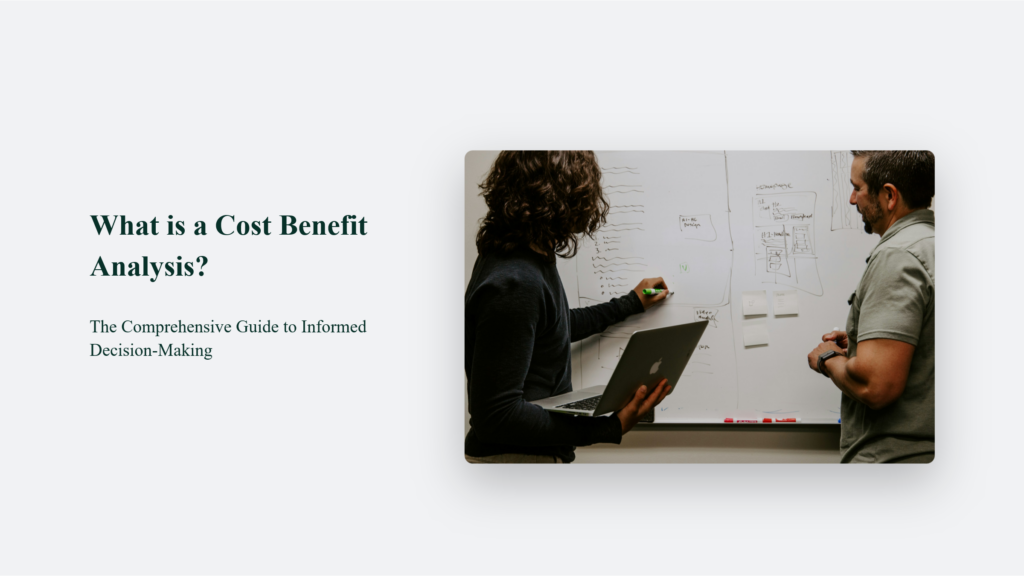

What is a Cost Benefit Analysis? The Comprehensive Guide to Informed Decision-Making

As Seen On
Making informed decisions is paramount in the ever-evolving business and personal finance landscape. Enter the cost benefit analysis – a powerful tool that helps you weigh the pros and cons of any given endeavor.
This comprehensive guide will dive deep into the world of what is a cost benefit analysis, exploring its intricacies and demonstrating how you can harness its power to make smarter, more strategic choices.

What is a Cost Benefit Analysis?
At its core, a cost benefit analysis is a systematic process that evaluates the potential costs and benefits of a decision, project, or investment. It’s a way to determine whether the benefits outweigh the costs, and if so, by how much. This analysis is essential for making informed decisions, as it provides a clear picture of the potential outcomes and helps you avoid costly mistakes.
Anecdote: Imagine you’re a small business owner considering expanding your product line. You’ve researched and believe introducing a new product could increase your revenue. However, you may need to find out if the costs associated with development, production, and marketing will be worth it in the long run. A cost-benefit analysis allows you to crunch the numbers and determine whether the potential benefits justify the costs.
The Key Components of a Cost Benefit Analysis
When conducting a cost-benefit analysis, it’s essential to consider all potential factors that could impact the outcome of your decision. By carefully evaluating each component, you can understand the costs and benefits of a given course of action.
Let’s take a closer look at the six key components you’ll need to consider:
Direct Costs:
Direct costs are the most obvious expenses associated with a project or decision. These are the tangible costs that are directly tied to the execution of the project, such as:
- Materials: The cost of any physical goods or supplies needed to complete the project.
- Labor: The workforce cost required to carry out the project, including salaries, benefits, and taxes.
- Equipment: The cost of any machinery, tools, or technology necessary for the project.
Indirect Costs:
Indirect costs are expenses not directly associated with the project but are still necessary for its completion. These costs can include:
- Overhead expenses: The costs of maintaining a business, such as rent, utilities, and insurance.
- Administrative costs: The costs of managing the project, such as accounting, human resources, and legal fees.
Intangible Costs
Intangible costs are the most difficult to quantify, as they don’t have a clear monetary value. These costs can include:
- Employee morale: The project’s potential impact on the well-being and satisfaction of your workforce.
- Customer satisfaction: The project’s potential impact on your customers’ happiness and loyalty.
- Reputation: The project’s potential impact on your brand image and public perception.
Direct Benefits
Direct benefits are the most obvious advantages of a project or decision. These are the tangible benefits that are directly tied to the execution of the project, such as:
- Increased revenue: The potential for the project to generate additional income for your business.
- Cost savings: The potential for the project to reduce expenses and improve efficiency.
Indirect Benefits
Indirect benefits are advantages not directly associated with the project but still result from its completion. These benefits can include:
- Improved brand recognition: The potential for the project to increase awareness and positive perception of your brand.
- Market share: The potential for the project to help you capture a larger portion of your target market.
Intangible Benefits
Intangible benefits are difficult to quantify, as they need a clear monetary value. These benefits can include:
- Customer loyalty: The potential for the project to increase the likelihood that customers will continue to choose your brand over competitors.
- Employee satisfaction: The potential for the project to improve the happiness and engagement of your workforce.
Conducting a Cost Benefit Analysis: A Step-by-Step Guide
Now that you understand the key components of a cost benefit analysis, let’s walk through the process step-by-step.
Step 1: Define the Problem
Clearly define the problem or opportunity you’re addressing. What are your goals and objectives? What are the potential solutions?
Step 2: Identify Costs and Benefits
List all the potential costs and benefits associated with each solution. Consider both tangible and intangible factors.
Step 3: Assign Values
Assign a monetary value to each cost and benefit. For intangible factors, use your best judgment to estimate their worth.
Step 4: Calculate Net Present Value
Use the net present value (NPV) formula to determine the present value of future costs and benefits. It considers the time value of money and allows you to compare the value of different options.
Step 5: Analyze Results
Compare the NPV of each option and determine which offers the greatest benefit relative to its cost. Remember that the option with the highest NPV may not always be the best choice – consider other factors, such as risk and alignment with your goals.
Real-World Examples of Cost Benefit Analysis in Action:
To illustrate the power of cost benefit analysis, let’s look at a few real-world examples:
Example 1: The City of Portland’s Bike Lane Project In 2009, the City of Portland conducted a cost-benefit analysis to determine the feasibility of installing a network of bike lanes throughout the city. The study found that the project would cost $60 million but generate $900 million in benefits over 30 years, including reduced healthcare costs, increased productivity, and reduced traffic congestion. Based on these findings, the city moved forward with the project, which has since become a model for other cities worldwide.
Example 2: Apple’s Decision to Develop the iPhone When Apple was considering developing the iPhone, it conducted a thorough cost-benefit analysis. It estimated the costs of development, production, and marketing and weighed them against the potential benefits, such as increased market share and revenue. The analysis showed that the benefits outweighed the costs, and Apple moved forward with the project. The rest, as they say, is history.
Key Takeaway:
Cost benefit analysis is a powerful tool that can help you make informed decisions and avoid costly mistakes. By carefully considering a given endeavor’s potential costs and benefits, you can determine whether it’s worth pursuing and make strategic choices that align with your goals. Whether you’re a business owner, a project manager, or an individual making personal finance decisions, incorporating cost benefit analysis into your decision-making process can help you achieve better outcomes and maximize your chances of success.
Conclusion:
In a world where decisions can have far-reaching consequences, cost benefit analysis is an invaluable tool for making informed choices. By carefully considering the potential costs and benefits of a given endeavor, you can avoid costly mistakes and maximize your chances of success. So the next time you’re faced with a significant decision, take the time to conduct a cost benefit analysis – your future self will thank you.
Konger
Up until working with Casey, we had only had poor to mediocre experiences outsourcing work to agencies. Casey & the team at CJ&CO are the exception to the rule.
Communication was beyond great, his understanding of our vision was phenomenal, and instead of needing babysitting like the other agencies we worked with, he was not only completely dependable but also gave us sound suggestions on how to get better results, at the risk of us not needing him for the initial job we requested (absolute gem).
This has truly been the first time we worked with someone outside of our business that quickly grasped our vision, and that I could completely forget about and would still deliver above expectations.
I honestly can't wait to work in many more projects together!
Disclaimer
*The information this blog provides is for general informational purposes only and is not intended as financial or professional advice. The information may not reflect current developments and may be changed or updated without notice. Any opinions expressed on this blog are the author’s own and do not necessarily reflect the views of the author’s employer or any other organization. You should not act or rely on any information contained in this blog without first seeking the advice of a professional. No representation or warranty, express or implied, is made as to the accuracy or completeness of the information contained in this blog. The author and affiliated parties assume no liability for any errors or omissions.

